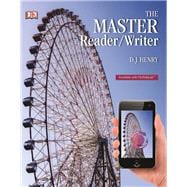0133946622 / 9780133946628 The Master Reader/Writer Plus MySkillsLab with Pearson eText - Access Card Package
For courses in Integrated Reading and Writing.Package consists of:
- 0133995151 / 9780133995152 MySkillsLab with Pearson eText - Inside Star Sticker
- 0133995178 / 9780133995176 MySkillsLab with Pearson eText - Glue In Access Card
- 0321927397 / 9780321927392 The Master Reader/Writer
Explores reading and writing skills at the advanced level, with emphasis on process
The Master Reader/Writer offers a balanced approach to literacy by bringing instruction for reading and writing together in one resource. As similar and complementary communication processes, reading and writing both have recursive before, during, and after phases–and the outcome of both is that the individual constructs his or her own meaning. This text builds on these similarities.
Continuing the success of the first book in this series, The Effective Reader/Writer, the revolutionary design of The Master Reader/Writer reinforces the writing, reading, and thinking processes by showing students visually how they are interconnected. Students have ample practice to focus on individual skills, along with challenging writing situations in which to apply these skills in their own writing. This approach fosters engaged learning and metacognition.
The reading/writing process is introduced and illustrated in Unit 1 with two-page four-color graphics that explain this processes as a strategy that students apply to reading and writing in everyday life, college life, and working life to comprehend and compose text. In each module opener, the photographic organizer introduces the concept of the module and encourages students to think critically about the concept. Throughout each module, examples and explanations engage students as active learners; then practice exercises and writing workshops offer opportunities for students to apply what they learn and test their understanding. Each module ends with a series of post-lesson actives such as Writing Workshops, Reading/Writing Assignments for Every day, College and Working Life; Review Tests; Academic Learning Logs and a Capstone academic reading and writing assignment with one to three readings relevant to the modules overarching theme.
Also Available with MySkillsLab ®
This title is also available with MySkillsLab–an online homework, tutorial, and assessment program designed to engage students and improve results. Within its structured environment, students practice what they learn, test their understanding, and pursue a personalized study plan that helps them better absorb course material and understand difficult concepts. MySkillsLab is also available with full eText and a selection of exercises and writing assignments tied directly to the textbook.For each chapter, students are directed to the corresponding section in MySkillsLab for further practice and review.









